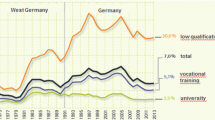Abstract
The article reviews the factors underlying Germany's exceptional labour market performance since 2005. It attributes labour market turnaround to powerful social reforms strengthening labour supply and effectiveness of public employment services, assisted by cooperative social partners moderating wage growth. In the great recession, ongoing transition to low-unemployment equilibrium, peculiarities in the export cycle, and private arrangements supporting labour hoarding, rather than discrete policy changes, kept employment at unpredicted levels. While these features scarcely transfer to other circumstances, the policies that evidently lifted Germany to lasting higher employment levels may provide valuable blueprints for countries struggling with current structural unemployment crises.

Similar content being viewed by others
Notes
See, for example, Wunsch (2005) for a more detailed overview of the labour market development after German unification.
See Eichhorst et al. (2010) for a detailed description of the changes in the German unemployment insurance system.
The group of non-unemployed employable long-term unemployed includes participants in active labour market programmes, individuals in minor employment, individuals aged 58 and above, individuals in education and individuals who need to give care to children or relatives.
A serious drawback is that due to the two competing administrative systems reliable time series information for the entire long-term unemployed does not exist.
Jacobi and Kluve (2007) survey the empirical evidence on the effectiveness of labour market services and policies before and after the reforms. Eichhorst and Zimmermann (2007) is another excellent survey focusing on active labour market instruments.
This subsidy scheme and an earlier one, the so-called bridging subsidy (‘Überbrückungsgeld’), in 2006 were merged into one, less-well designed scheme, the so-called start-up subsidy (‘Gründungszuschuss’). See Caliendo and Kritikos (2009) for a critical review.
At least in the cases where employer organizations have supported the minimum wage, one may reckon that other aspects like impairing competition from outsiders play a role.
See Caliendo (2009) for a review of the measures that have fostered labour supply.
See Rinne and Zimmermann (2011) for a helpful survey.
References
Bauer, T, Bender, S and Bonin, H . 2007: Dismissal protection and worker flows in small establishments. Economica 74 (5): 804–821.
Beninger, D, Bonin, H, Horstschräer, J and Mühler, G . 2010: Wirkungen eines Betreungsgeldes bei bedarfsgerechtem Ausbau frühkindlicher Kindertagesbetreuung. Quarterly Journal of Economic Research 79 (3): 147–168.
Blanchard, O . 1997: The medium run. Brookings Papers in Economic Activity 1997 (2): 89–159.
Bonin, H and Schneider, H . 2006: Wirksamkeit der Förderung der beruflichen Weiterbildung vor und nach den Hartz–Reformen. Wirtschaftspolitische Blätter 52 (1): 161–172.
Boockmann, B, Zwick, T, Ammermüller, A and Maier, M . 2012: Do hiring subsidies reduce unemployment among older workers? Evidence from two natural experiments. Journal of the European Economic Association 10 (4): 735–764.
Boysen-Hogrefe, J and Groll, D . 2010: The German labour market miracle. National Institute Economic Review 214 (1): 38–49.
Brenke, K, Rinne, U and Zimmermann, KF . 2011: : Short-term work: The German answer to the great recession IZA Discussion Paper No. 5780, Bonn.
Burda, M and Hunt, J . 2011: What explains the German labour market miracle in the great recession? CEPR Discussion Paper No. 8520, London.
Caliendo, M . 2009: Income support systems, labour market policies and labour supply: The German experience, IZA Discussion Paper No. 4665, Institute for the Study of Labour, Bonn.
Caliendo, M and Kritikos, A . 2009: Die reformierte Existenzgründungsförderung für Arbeitslose – Chancen und Risiken. Perspektiven der Wirtschaftspolitik 10 (2): 189–213.
Caliendo, M and Künn, S . 2011: Start-up subsidies for the unemployed: Long-term evidence and effect heterogeneity. Journal of Public Economics 95 (3–4): 311–331.
Clauss, M and Schnabel, R . 2008: Distributional and behavioural effects of the German labour market reform. Journal of Labour Market Research 41 (4): 431–446.
Dlugosz, S, Stephan, G and Wilke, R . 2009: Fixing the leak: Unemployment incidence before and after the 2006 reform of unemployment benefits in Germany, ZEW Discussion Paper No. 11-013, Mannheim.
Eichhorst, W, Grienberger-Zingerle, M and Konle-Seidl, R . 2010: Activation policies in Germany: From status protection to basic income support. German Policy Studies 6 (1): 59–100.
Eichhorst, W and Zimmermann, KF . 2007: And then there were four … how many (and which) measures of active labour market policy do we still need? Applied Economics Quarterly 53 (3): 243–272.
Fahr, R and Sunde, U . 2009: Did the Hartz reforms speed-up the matching process? A macro evaluation using empirical matching functions. German Economic Review 10 (3): 284–316.
Federal Labour Agency – Bundesagentur für Arbeit. 2011: Sockel- und Langzeitarbeitslosigkeit, Broschüre der Arbeitsmarktberichterstattung. Nürnberg.
Gartner, H and Klinger, S . 2010: Verbesserte Institutionen für den Arbeitsmarkt in der Wirtschaftskrise. Wirtschaftsienst 2010 (11): 728–734.
Jacobi, L and Kluve, J . 2007: Before and after the Hartz reforms: The performance of active labour market policy in Germany. Journal of Labour Market Research 40 (1): 45–64.
Möller, J . 2010: The German labour market response in the world recession – De-mystifying a miracle. Journal of Labour Market Research 42 (4): 325–336.
Rinne, U and Zimmermann, KF . 2011: Another economic miracle? The German labour market and the great recession, IZA Discussion Paper No. 6250, Bonn.
Spermann, A . 2011: The new role of temporary agency work in Germany, IZA Discussion Paper No. 6180, Bonn.
Wunsch, C . 2005: Labour market policy in Germany: Institutions, instruments and reforms since unification, Discussion Paper 2005–06, Department of Economics, University of St. Gallen.
Author information
Authors and Affiliations
Rights and permissions
About this article
Cite this article
Bonin, H. The Two German Labour Market Miracles: Blueprints for Tackling the Unemployment Crisis?. Comp Econ Stud 54, 787–807 (2012). https://doi.org/10.1057/ces.2012.39
Published:
Issue Date:
DOI: https://doi.org/10.1057/ces.2012.39




